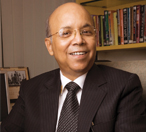 When he starts talking about higher education, one cannot help but just quietly listen and absorb what he is saying. He should know, for he has been in management education, research, consulting and institution building for over 37 years. Dr Rajan Saxena, Vice Chancellor and Distinguished Professor of Marketing at the NMIMS (Narsee Monjee Institute of Management Studies) Deemed University, is of the opinion that the demographic profile today has created an opportunity for good quality education in all sectors. Even so, as a country, we are still far behind in terms of capacity. And it is just not that we lack, we are also faced by a greater challenge: how to make our capacity competitive with respect to the world.
When he starts talking about higher education, one cannot help but just quietly listen and absorb what he is saying. He should know, for he has been in management education, research, consulting and institution building for over 37 years. Dr Rajan Saxena, Vice Chancellor and Distinguished Professor of Marketing at the NMIMS (Narsee Monjee Institute of Management Studies) Deemed University, is of the opinion that the demographic profile today has created an opportunity for good quality education in all sectors. Even so, as a country, we are still far behind in terms of capacity. And it is just not that we lack, we are also faced by a greater challenge: how to make our capacity competitive with respect to the world.
Tracing the reputation of some of the finest first universities of India, including Nalanda, Shantiniketan and Pataliputra, and coming to the current situation, Dr Saxena opines that as we increased capacity. the quality of education imparted suffered as no one bothered to develop teachers. “We need to create an ecosystem in education to attract talent, especially as educators,” he says, with a look of hope in his eyes. He knows this is possible since he has been able to achieve that in all the institutes he has been associated with. In the recent scenario, Dr Saxena feels that our system is still reeling under the blow of the eighties and the nineties where during the upsurge, apart from the quality of teachers suffering, corruption set in to what was until then ‘a noble profession’. “The skewed demand and supply situation made it possible to auction seats and made capitation fee a norm,” he says.
Aspirations were going up so fast that almost everyone wanted a professional education, at any cost. As a result, with the field expanding, anyone with money set up an education system to claim a slice of the pie. Not all these institutes are of the standard that one expects. In fact, most are not. “Consequently, this sector is a poor sector, or even ‘virtually sick’,” he avers.
According to Dr. Saxena, growth occurs with great minds entering the field with a passion. “To quote the cliché, out-of-thebox thinking is required, and with talented personnel entering to teach, the employability of students will multiply,” he says. In his opinion, only about 20 per cent of our professional graduates, be it engineering or management students, are employable. Despite what seem like mammoth issues coming down on the sector, there are some that are going for it. “There is a responsiveness to the market needs like never before,” says Dr. Saxena, adding, “several innovations have taken place in terms of designing of highly specialised programmes.”
He envisions that the 2010-20 decade is going to be one of quality revolution just as 2000-10 was of infrastructure development in education and 1990-00 one of capacity creation. If that is the case, then he hopes there will be a win-win situation for the academia as well as the industry.
Volume 1 Issue 6





























